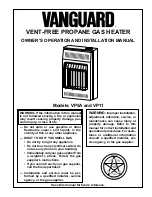
18
and check for damage. Do not use the heater if it is damaged or malfunctioning, but
have it inspected/repaired!
In case of internal overheating, the
overheating safeguard
will switch the heater off.
This may occur if the heater cannot give off enough heat or if it cannot draw in
enough fresh air. As mentioned above, this is generally caused by (partially) covering
the heater, blocking the air inlet and outlet openings or installing the heater too close
to a wall or something similar. When the heater has cooled down sufficiently, it will in
principle start again automatically, however if you do not remove the cause of the cut-
off then this will probably be repeated. Regular overheating can give rise to
irreparable damage.
When the overheating safeguard switches the heater off, set the mode selector dial
to ‘OFF’ (off), unplug and allow the heater to cool down. Remove and/or amend the
cause of overheating and reuse the heater as normal. If you cannot find a cause and
overheating recurs, stop using the heater, and take it in for inspection/repair.
Cleaning and Maintenance
Keep the heater clean. Deposits of dust and dirt in the appliance are a common
cause of overheating so these should be removed regularly. Switch off the heater,
remove the plug from the socket and allow the heater to cool down before cleaning or
carrying out maintenance work.
Wipe the outside of the heater regularly with a dry or slightly damp cloth. Do not
use aggressive soaps, sprays, cleaners or abrasives, waxes, polishes or
chemical solutions!
Carefully use a vacuum cleaner to remove dust and dirt from the grills.
The heater contains no other parts which need maintenance.
At the end of the season, store the cleaned heater in the original packaging if
possible. Store upright in a cool, dry and dust-free place. If necessary, remove
the wheel supports.
Do not dispose of heater with household waste when if becomes worn or
damaged beyond repair. Take it to your local authority's collection point for
electrical appliances where any reusable materials will be collected and
redistributed.
CE-statement
Euromac bv, Genemuiden-NL
hereby declares that the
EUROM
electric radiator
heater, type
Radiator Eco 1500
, complies with the LVD guideline 2006/95/EC and
the EMC guideline 2004/108/EC and meets the following standards:
EN 60335-1:2012+A11:2014
EN 55014-1:2006+A1:2009+A2 :2011
EN 60335-2-30:2009+A11:2012
EN 55014-2:1997+A1:2001+A2:2008
EN 62233:2008
EN 61000-3-2:2014
EN 61000-3-3:2013
Genemuiden, 22-06-2015
W.J. Bakker, alg.dir,







































